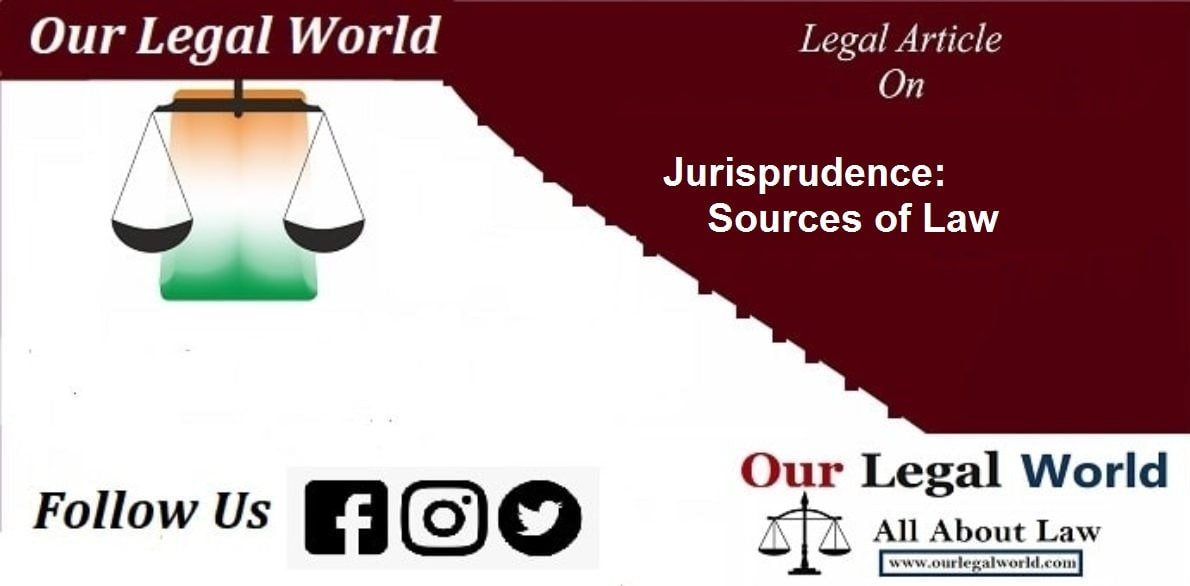Jurisprudence: Sources of Law
Introduction
Jurisprudence is basically the study of the Theory and Philosophy of Law. In jurisprudence we do not deal with the practically applicable pieces of statutory law, rather we try to understand the very essence of law and its various dimensions. The word source of law is used in various senses. The common source of law is customs, codified law, judicial precedent, etc. with the growing popularity of codified law and precedent in modern states replacing various other sources of law. There are many differences among jurists regarding the source of the law.
CLAT AILET LLM Jurisprudence Notes
a) According to Austin’s : The source of law includes three meanings –
- 1. Direct authority ( sovereign)
- 2. Historical documents ( codes ).
- 3. Causes hat make society’s laws the force of law.( legislation, customs etc.)
b) According to C.K. Allen : He uses it in the sense of agencies, through which the rules of conduct acquire the character of the law by becoming fixed, uniform and mandatory.
c) According to Holland : The apparent source of law is sometimes refers to the quarter where we can gain knowledge of the law.
d) According to Salmond: According to Salmond there are two main sources of law –
I. Formal sources: Formal sources are those sources from which the law derived its force and validity. It is the will of the state as manifested in statutes or decisions of the court. Professor Allen considered that the concept of a formal source is wholly and necessary because it simply means that the state will recognize a law that is a law .
II. Material sources : These sources drives the matter, but not the validity. These sources are further divided into two sources : legal sources and historical sources .
• Legal sources: Legal resources that are the sources which is not only in fact, but also in law and officially.
- Legislation ( enacted law ),
- Precedents ( case law),
- Customs
- Conventional law ( based on agreements e.g. local law , treaties etc.)
Historical sources: Historical sources are those sources that are really in fact only and unauthorized.
• Example:
- Legal writings ,
- Juristic opinions,
- Foreign judgements,
- Constitution etc.
Common sources of law :
There are three major sources of law that can be identified in any modern society are as follows :
- Legislation
- Judicial precedents
- Customs .
Legislation
Legislation As a source of law :The legislation is considered as the most important source of law . The term legislation is derived from the Latin word legis which means law and latum means to make or set. Therefore, the word legislation means the making the law.- Legislation is the source of law which is included in the declaration of legal rules by a competent authority. The Legislature is the direct source of law.
- The Legislature frames new laws, revises old laws and repeals existing laws in all countries. It is the most important source of law making in modern times.
- The word legislature means to make the law. Its scope is now limited to a particular form of law making. This not only creates new rules of law but also removes existing inconvenient rules.
Types of legislation :
There is mainly two types of legislation –
- Supreme legislation
- Subordinate legislation.
• Supreme Legislation: Supreme law is an expression of the legislative will of the supreme authority in a state. It is supreme because no authority can modify, amend or control it. It transfers sovereign or supreme legislative power to the state, and is therefore, unable to be repealed by any other legislative authority.
Example : Acts of parliament and the ordinances and other laws made by the president and governors , is the example of supreme legislation.
• Subordinate legislation: Subordinate law is that which transfers any authority other than sovereign legislative power, and is, therefore, dependent on some superior or supreme legislative authority for its existence or legitimacy. It comes from a subordinate legislature or any authority and is subject to the repeal or approval of a superior law.
Example : It includes rules, regulations bye- laws , orders, directions, notifications etc . made by various authorities, municipalities, universities and government departments, supreme and high courts etc.
Types Of Subordinate Legislation-
There is five types of Subordinate Legislation which are following- 1.Colonial legislation– The laws made by colonial countries for their colonies or the countries controlled by them are known as colonial laws. In olden times, India was governed by laws that were passed by British governments, although many countries around the world gained independence from colonial power. It is not the most important in modern times. The Parliament has the power to repeal any act.
2.Executive legislation : Although the main function of the executive is to enforce laws, in some cases, the power to make rules is delegated to various departments of the government, which are called subordinate delegated legislation.
3.Judicial legislation : This means the rules of procedure made by the superior courts under the authority for their own guidance which are entrusted to them for this purpose. In other words, superior courts have the power to make rules for the regulation of their procedures.
4.Municipal legislation: Sometimes municipal authorities have the right to establish special laws for the districts under their control. They are allowed to make bye-laws for limited purposes within their territories. These are the laws of local bodies such as municipal or corporation.
5.Autonomous legislation: It is the process of law-making by individuals for their own guidance by the state. These are autonomous bodies such as municipal councils, universities, etc.
Judicial Precedents As a source of law
• Judicial precedents is an important source of law , but it’s neither as modern as legislation nor as it as old as custom
• Precedent means, the judgment or decision of the decision of the court cited as a right of implied legal principle.
• The doctrine of precedent, also known as stare decisis, which means standing by judgment, is based on the principle that like cases should be decided alike . Once a case has been decided by the judge to apply the principle, when similar facts arising in the future should also be decided by applying the same principle.
• This does not always save the time and labour of judges, but also maintains certainty, predictability and uniformity in the applications of law.
Types of judicial precedents:
There is mainly four types of judicial precedents:
- Original precedents.
- Declaratory precedents
- Authoritative precedent
- Persuasive precedent.
Original and Declaratory Precedents:
• Judicial decisions are of two types, namely those that make a new law, and those which apply known and systematic principles to particular facts of the law. Both such decisions are considered precedents. The reason for this is that courts have official guides to determine future disputes.
• New lawmaking decisions are called original precedents, while those that apply known and systematic principles of law to particular facts of a case are called declaratory precedents. A declaratory precedent is not a source of law but while original precedents are the core principle.
Also Read: SOURCES OF INTERNATIONAL LAW
Authoritative and Persuasive precedent:
• The classification of precedent into authorotative and persuasive is a widely accepted classification. An authoritative precedent is that a judge is bound to consider whether he accepts it or not. In other words, the judge has no choice.
• For example, the decisions of the Supreme Court of India are binding on a judge of the Kerala High Court. Similarly, a decision of the Kerala High Court is binding on the lower courts of Kerala. In the system of precedent, the decisions of superiors are always regarded as authoritative precedents.
• The authoritative precedent is further classified into two categories :
- Absolute and
- Conditional precedent.
• An persuasive precedent is one that has no compulsion to follow. Here, he has the option to decide whether to follow a precedent. If he is convinced of the guilt of virtue of a decision, he can follow it; Otherwise he can refuse.
• For example: A decision of the Delhi High Court is only a persuasive precedent, as far as the Madras High Court is concerned, there is no compulsion to follow it. Foreign decisions can also be considered persuasive.
Precedents of precedents : There is two major principle of precedent:
1.Ratio decidendi (reason for decision) – An official principle of a judicial decision. It contains the principle of law formulated by a judge, it is necessary for the decision of a case. It has the force of law and courts to be binding.
• Prof . Keeton defines that – Ration decidendi is a principle of law that forms the basis of a decision in a particular case. Bridge v. Hawkworth, the customer found money on the floor of a shopping complex, both the customer and the shopkeeper claim that money. The court considered the shop a public place and applied the rule finder keeper and it favored the customer. Here the ratio decidendi is the finder of goods is the keeper principle.
2.Obiter Dictor ( said by the way ) : The obiter dictum stated by the judge is not some binding right. The judge may declare certain general principles related to the law, but it may be unnecessary and irrelevant to the issues before him. Those unnecessary statements of law that enforce a rule are called obiter dictor.
3.Custom as a source of law :
Custom is the oldest and important source of law. They exist as established usage, they are nothing but usage and habits. Custom means uniformity of conduct of people which is followed by any part of community or whole community .
a.According to Holland: Custom means the course of conduct that is commonly observed.
B. According to keeton : Custom as to those rules of humans action ,established by usage and regarded as to be legally binding by those to whom the rules apply which are adopted by the court and applied by the source of the law because they are generally in whole or in part followed by political society.
C. According to Austin: customs are a standard of direct that the sovereign suddenly sees and does not conform to the law set by the political superior.
Example of custom- The example of custom is Saptapadi, it is most important in Hindu marriage ceremony. Saptapadi means seven steps after tying the mangalsutra, the newly wedded couple held the ground in seven steps as a sacred fire called the Saptapadi. Section 7 of the Hindu Marriage Act 1955 deals with the same.
Kinds of Customs:1 .Custom without sanction: Such customs are non-mandatory in nature and are followed because there is a public opinion.
2.Custom without sanction: These customs are tied to nature and enforced by the state. This custom can be further divided into two categories –
A. Legal custom.
B. Conventional custom.
A Legal custom : It’s custom whose authority is absolute .It has the force of law. It is recognized and enforced by the court.
Legal custom has also divided in two parts:
I. General Custom/ Customs for all.
II. Particular Custom/ Local Custom.
I. General customs / customs duties for all : There is a common custom that conquers all through the nation and it has a rule that everyone should follow.
II. Local Custom / Special Custom : A local custom is one that is practiced in a particular area, which is a region, city, or re-area. They do not estimate the area of the land as they may be.
B. Conventional custom – Similarly a conventional custom is called “usage”. It is a setup, whose authority depends on its acknowledgment and organization in agreement between the assemblies assembled by it. In basic terms, a conventional custom is a contingency and the condition is that it will tie on the parties only on the occasion that it is accepted and consolidated by them in their agreement.
Requisites of a valid custom:
There is many essential elements of valid Custom which are following-
I. Custom must be ancient : A custom cannot be created in a day. It should be a long lasting one. Unlike England, where a custom has existed from ancient time . In India Long usage or observance is sufficient. It may be considered as a valid custom if it’s ancient or immemorial.
Case law : In Gokul Chand v. Praveen Kumar, the Supreme Court dated 1189 AD. Decided to measure the validity of custom and clearly stated that it should be of ancient and historical period.
II. Custom must be continuous, certain and precise: .The custom must have been in use continuously , its can’t break by any particular community for a time period . It is must continuous process and it should not be vague or indefinite. Its existence must be proved by clear, unambiguous evidence.
Case law : Hampton v. Hono it was ruled that if a significant amount of time was not practiced for a custom, it would not exist as a valid custom.
Case law : Wilson v. Wilson. In this case privy council said that – If a particular custom is vague, unclear and cannot be understood by the parties then the particular custom will be declared null and void by the court.
III. Reasonable – There must be a custom within the limits of reason to be considered legally binding. Therefore, if it contradicts the principles of justice, equality and good conscience, the custom will be considered unfair or unreasonable.
Case law : Brokers co. V. Olympia oil l & Coke co., The court Recognized customs as “reasonable and legitimate and, for example, sensible, genuine and impartial men
IV. Consistent with morality and public policy: Custom must not be inconsistent with morality, public order and with other customs in some region .
Case law : In Buldano v. Fasir, A custom, where a woman was allowed to remarry again during her husband’s lifetime, was declared null and void by the court because it was against public policy.
V. Conformity with Statutory law: No custom however ,old or reasonable can stand if it is conflict with a statue or legislation or any part of it . Custom can’t infringe the fundamental rights of any person. If he does so, it will be declared null and void by the court.
VI. Custom must have been obligatory force : Custom must have been enjoyed as of right because without this it cannot be said that it exists compulsory pressure to conform. Customs must be followed openly and enjoy fully without the need for resources of force.
Conclusion: Finally we can conclude that, to interpret any law it is important to understand the source of the law. This is why the subject of law sources has attracted the attention of many jurists, thinkers and legal theorists. Custom in ancient times, the most important source of law. Now with the growth of legislation and precedent it is decreasing.
Reference:
1 V.D. Mahajan , jurisprudence and legal theory , 5th edition .
2 W. Friedmann, legal theory, 5th edition.
3 A.K. Jain , jurisprudence book
4 Www. legalbites.com
5 www.topper.com
6 Www.ipleaderblog.com
7 Www.lawyered.in
8 Www.desikannon.com
9 Www.legalseriveIndia in




![Call for Campus Ambassadors by Our Legal World [2 Months; Virtual]: Apply by June 15](https://www.ourlegalworld.com/wp-content/uploads/2024/06/Logo-New-136x150.png)


